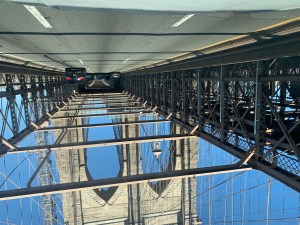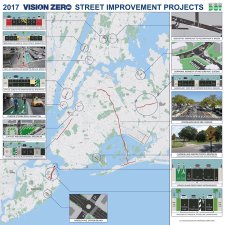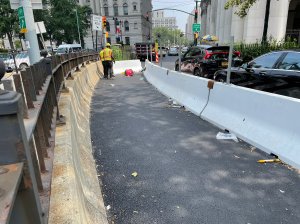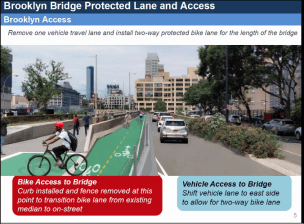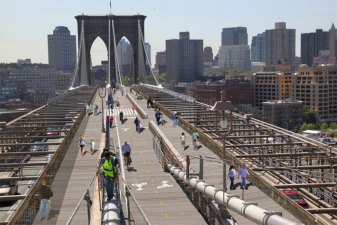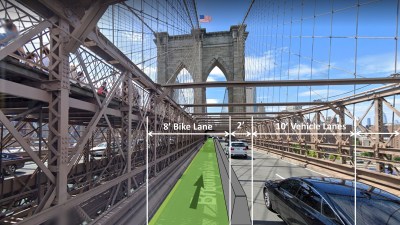DE BLASIO HAS PUNTED: So How Will The Next Mayor Fix the Brooklyn Bridge?

The de Blasio administration has made it clear that it will pass into history before fixing the ongoing disaster that is the Brooklyn Bridge promenade. Department of Transportation Commissioner Polly Trottenberg has for years sloth-walked a proposed widening of the dangerously crowded shared bike and footpath, and even had to row back an aide’s comment last month that the agency was considering taking a lane from drivers in favor of a bike lane.
Despite consistent pressure from elected officials and advocates, Mayor de Blasio is content to run out its 18-month clock. So as a wise man once asked, “Who’s next?”
Streetsblog asked five candidates who are running, or expected to run, for mayor what they would do about the overcrowded conditions if elected. Brooklyn Borough President Eric Adams, City Council Speaker Corey Johnson and Comptroller Scott Stringer responded (Diane Morales and Loree Sutton did not respond to a request for comment):
Eric Adams
The conditions on the promenade of the Brooklyn Bridge have become hazardous to pedestrians and cyclists alike, and we need to look at bold solutions that provide safe access for all modes of transportation. We should explore options that don’t just think outside the box, they break the box. We could look at a “ribbon bridge” model, like the one proposed by Sam Schwartz, that is exclusive to pedestrians and cyclists. As the current pandemic forces us to evaluate our transportation system, and as congestion pricing comes online and resets the baseline of traffic levels, we have to create an infrastructure that encourages people to move about our city safely and accessibly.
Corey Johnson
The Council continues to look for creative ideas on how to improve the Brooklyn Bridge and the East River crossings for bus riders, pedestrians, and cyclists. What is clear is that any viable solution will involve taking space on the bridge currently given to cars and reallocating it to better serve more sustainable transit options. The Brooklyn Bridge is an iconic part of our city and I look forward to the day when it better serves New Yorkers on foot, on a bike, or on a bus.
Scott Stringer
With Brooklyn Bridge car traffic falling by 30 percent in the last 20 years; congestion pricing and two-way Verrazzano tolling on the horizon; and bike traffic rapidly rising during the COVID-19 pandemic, it is far past time to rethink the Brooklyn Bridge. It’s clear that more space is needed for bikes, e-bikes, and pedestrians, and that those upgrades need to be in place soon, before the tourists return and the promenade traffic becomes completely untenable.
With two candidates directly declaring that they’d give cars less space on the Brooklyn Bridge and another suggesting a totally new piece of infrastructure for cyclists and pedestrians, it’s fair to say the the ideas on offer are bold, especially compared to the “Wait around for a study” stall tactic of the de Blasio DOT. Advocates were especially happy to hear the ideas that centered on removing room for cars on the bridge.
“The next mayor needs to understand that to keep up with the growing demand for cycling in the city, existing infrastructure choke points such as bridges need to be addressed,” said Transportation Alternatives Director of Organizing Erwin Figueroa. “We cannot continue to force pedestrians and cyclists to share one crowded path on the Brooklyn Bridge, while drivers get six travel lanes.”
Making less room for cars on the Brooklyn Bridge is also an avenue towards totally reimagining the street space in Downtown Brooklyn and Lower Manhattan, advocates said, tasking the next mayor with far more than simply reallocating space on a bridge.
“We strongly applaud mayoral candidates pledging action to create more space for people on the Brooklyn Bridge,” said Jon Orcutt of Bike New York. “Hopefully that would also come with a strong dose of transparency in terms of what NYC DOT is finding and thinking regarding options. We think the menu is expanding the promenade, taking part of the bridge roadway or going full East River High Line a la Massengale in connection with congestion pricing, squeezing the BQE, FiDi pedestrianization and an end to the placard system.”
